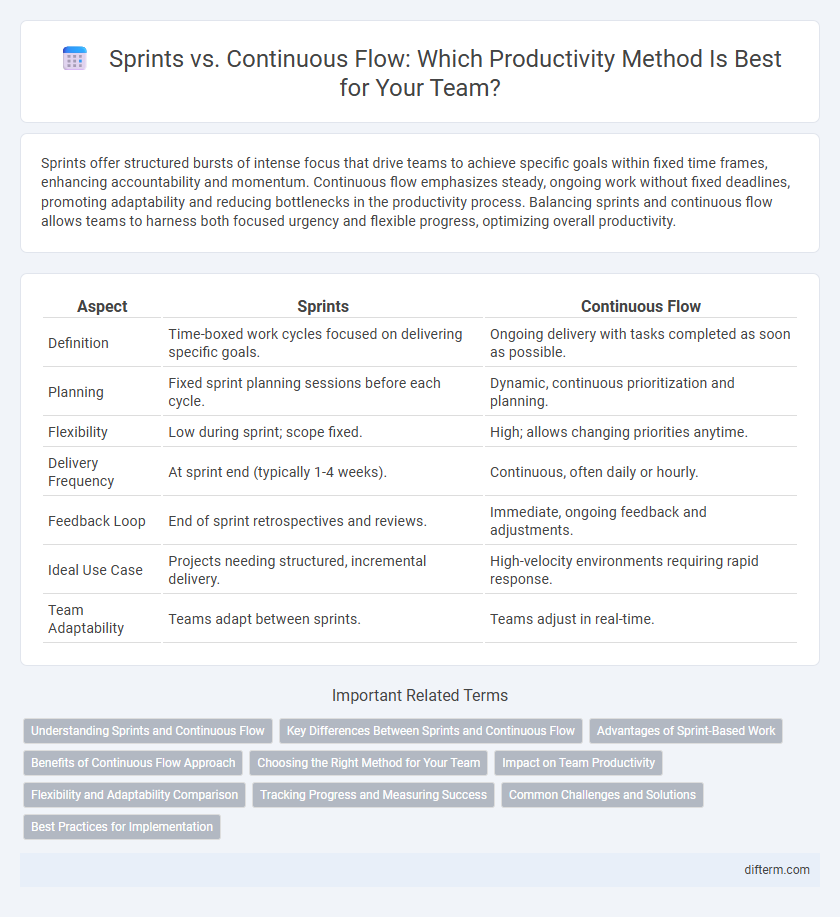Sprints offer structured bursts of intense focus that drive teams to achieve specific goals within fixed time frames, enhancing accountability and momentum. Continuous flow emphasizes steady, ongoing work without fixed deadlines, promoting adaptability and reducing bottlenecks in the productivity process. Balancing sprints and continuous flow allows teams to harness both focused urgency and flexible progress, optimizing overall productivity.
Table of Comparison
| Aspect | Sprints | Continuous Flow |
|---|---|---|
| Definition | Time-boxed work cycles focused on delivering specific goals. | Ongoing delivery with tasks completed as soon as possible. |
| Planning | Fixed sprint planning sessions before each cycle. | Dynamic, continuous prioritization and planning. |
| Flexibility | Low during sprint; scope fixed. | High; allows changing priorities anytime. |
| Delivery Frequency | At sprint end (typically 1-4 weeks). | Continuous, often daily or hourly. |
| Feedback Loop | End of sprint retrospectives and reviews. | Immediate, ongoing feedback and adjustments. |
| Ideal Use Case | Projects needing structured, incremental delivery. | High-velocity environments requiring rapid response. |
| Team Adaptability | Teams adapt between sprints. | Teams adjust in real-time. |
Understanding Sprints and Continuous Flow
Sprints structure work into fixed, time-boxed intervals, typically two to four weeks, enabling teams to focus on delivering specific goals with clear deadlines. Continuous flow emphasizes a steady, ongoing process where tasks are tackled one at a time, reducing bottlenecks and enabling rapid response to changing priorities. Understanding the distinct workflows of sprints and continuous flow helps teams optimize productivity by balancing predictability with adaptability.
Key Differences Between Sprints and Continuous Flow
Sprints operate on fixed time boxes, usually 1 to 4 weeks, enabling teams to focus on specific deliverables within a set period, while continuous flow emphasizes a steady, uninterrupted progression of tasks without fixed deadlines. Sprint methodology prioritizes iterative planning, reviews, and retrospectives to improve productivity and adaptability, contrasting with continuous flow's focus on minimizing work-in-progress and maximizing throughput. Key performance metrics differ, with sprints measuring velocity and deliverable completion per cycle, and continuous flow tracking cycle time and flow efficiency for ongoing task management.
Advantages of Sprint-Based Work
Sprint-based work enhances productivity by creating well-defined timeframes that boost focus and urgency, leading to faster delivery of high-priority tasks. Structured sprints encourage team collaboration and accountability, aligning efforts towards clear, measurable goals. Regular sprint reviews and retrospectives enable continuous improvement and adaptability to changing project requirements.
Benefits of Continuous Flow Approach
Continuous flow enhances productivity by minimizing task switching and reducing bottlenecks, allowing teams to maintain a steady work pace and deliver value continuously. This approach improves process visibility and flexibility, enabling quicker adjustments to changing priorities and customer demands. Continuous flow also supports higher quality outputs through ongoing feedback and incremental improvements without the constraints of fixed sprint cycles.
Choosing the Right Method for Your Team
Sprints provide structured, time-boxed periods ideal for teams needing clear deadlines and focused goals, enhancing accountability and measurable progress. Continuous flow suits teams with variable workloads, enabling ongoing task completion without interruption and promoting adaptability. Evaluating factors like project complexity, team size, and delivery frequency ensures selecting the optimal method for maximizing productivity and efficiency.
Impact on Team Productivity
Sprints create structured deadlines that boost team productivity by promoting focused work cycles and clear goal-setting, facilitating measurable progress within short time frames. Continuous flow optimizes productivity through uninterrupted task management, reducing context switching and enabling teams to adapt rapidly to changing priorities. Balancing sprints with continuous flow methodologies often enhances overall productivity by integrating disciplined pacing with flexible workflow adjustments.
Flexibility and Adaptability Comparison
Sprints offer structured time-boxed cycles that enhance focus and accountability but limit flexibility by adhering to fixed deadlines. Continuous flow enables teams to adapt quickly to changing priorities and deliver value incrementally without waiting for sprint boundaries. This adaptability in continuous flow supports dynamic work environments where responsiveness to evolving requirements is critical for sustained productivity.
Tracking Progress and Measuring Success
Sprints enable precise tracking of progress through time-boxed goals and velocity metrics, allowing teams to measure success with clear deliverables in fixed intervals. Continuous flow emphasizes real-time monitoring of work items and cycle times to optimize throughput and efficiency without defined deadlines. Both methods utilize key performance indicators (KPIs) like burndown charts for sprints and cumulative flow diagrams for continuous flow to assess productivity and identify bottlenecks.
Common Challenges and Solutions
Sprints often face challenges such as scope creep, time-boxing pressure, and burnout, which can be mitigated by clear backlog prioritization, realistic sprint planning, and regular retrospectives. Continuous flow struggles with work-in-progress limits and task prioritization, solvable through Kanban boards, strict WIP policies, and continuous stakeholder communication. Both methodologies benefit from adaptive workflows that integrate team feedback and agile tools to optimize productivity and maintain steady delivery.
Best Practices for Implementation
Implementing sprints requires clear goal-setting, time-boxed tasks, and regular retrospectives to enhance team focus and adaptability, while continuous flow emphasizes minimizing work-in-progress and optimizing cycle time for steady throughput. Best practices involve selecting the approach based on project complexity, team maturity, and delivery cadence, ensuring alignment with organizational goals. Leveraging tools like Kanban boards for continuous flow or Scrum ceremonies for sprints can significantly improve transparency and productivity.
Sprints vs continuous flow Infographic

 difterm.com
difterm.com